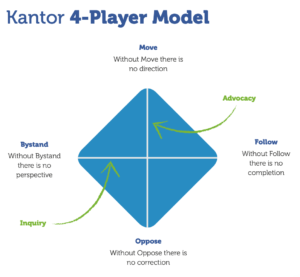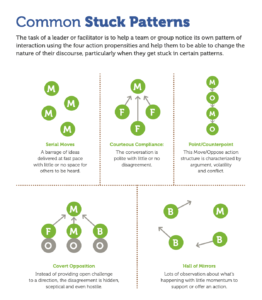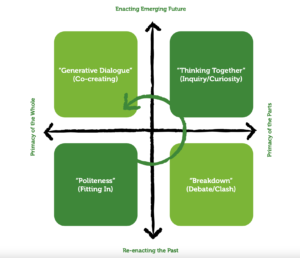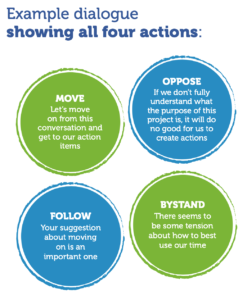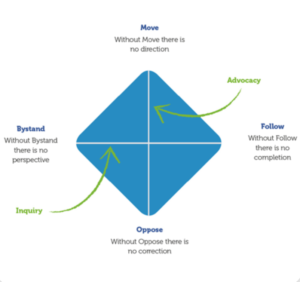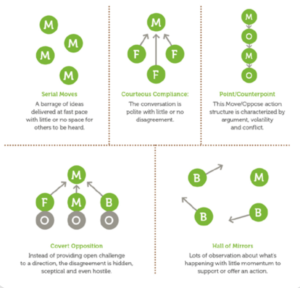Team Collaboration at Its Best, and Worst
Are you unintentionally stalling collaboration, in your team or your company?
Collaboration is a word that leaders use often. They know that when their team collaborates, everyone wins. As leaders they look good, their team members are happy and content, and their C-suite, well, they are thrilled with any and all tangible results!
The definition of collaboration as found in the Oxford dictionary defines it as ‘working with someone to produce or create something’. Reason follows that teams who produce results are winning teams.
What happens though, when leaders unintentionally stall or ruin the collaboration in their own team? What happens when they create a mess of their own doing? Often, nothing! Nothing happens. Sometimes the blame isn’t easily found and even when it is, it’s not easily attached to any one thing or person.
If your team is struggling to collaborate, may we suggest you look inward first. Look to see if you might be the cause of stalled or even ruined team collaboration.

3 Ways You Are Unintentionally Stalling Collaboration In Your Company
When your team fails, do you also? Many believe this is the case.
Here are 3 ways you might be (unintentionally) ruining team collaboration.
1 Undermining the team
If you are not present in a meeting, why should your team be?
If you micromanage, why should your team come forward with ideas?
If you don’t communicate clearly and often, why should your team know how to communicate with you?
Team collaboration starts with you. The leader:
- sets the tone and behavior for meetings
- reads the room and creates space for ideas and input
- communicates with the team and encourages two-way communication
Are you guilty of undermining the team?
Now that you know, can you ask yourself to do better?
2 Not listening with intent
Listening is a skill. As a leader, you need to listen with intent.
The intent of listening does not lie in the response, but the understanding of what is being said.
When anyone chooses to listen with intent, the result is hugely beneficial. Team collaboration, team morale, and team cohesiveness start to solidify and ultimately these become standard practice.
To quote Ernest Hemingway (Across the River and Into the Trees)
“When people talk, listen completely. Don’t be thinking what you’re going to say.
Most people never listen. Nor do they observe.
You should be able to go into a room and when you come out know everything that you saw there and not only that. If that room gave you any feeling you should know exactly what it was that gave you that feeling.”
Try that for practice.
3 Not remaining neutral
Conflict arises whether you expect it or not. It is human nature. Conflict arises when there are multiple people in a shared setting for an extended period, aka in a team setting.
Yes. Teams experience conflict. As a team lead, you are wise to expect (and welcome) conflict.
Conflict can come from:
- Unclear team roles
- Internal power struggles
- Insufficient training
- Differing ideals
- Challenges with communication
- Poor work environment
- Harassment and bullying
and many other contributing factors.
In How To Navigate Team Conflict and Stand Steadfast in the Storm we learn that standing in the storm is about staying with conflict and difference instead of avoiding it. Because conflict is inevitable the leader in you needs to recognize that different points of view generates conflict. But did you know conflict can provide clarity, discernment, deeper understanding, and energy? For those reasons, we encourage the gift of opposition.
Three tips to help you stand in the storm include:
- Cultivate self-awareness and management to stay in the situation
- Learn to press “Pause”
- Deepen your understanding of Group Dynamics
Exploring Tip #3, we find that models and frameworks are helpful for understanding group dynamics and for making sense of what we’re experiencing in the room.
Structural dynamics is a theory of face-to-face communications developed by David Kantor.
It provides a way to name the structure of communication as it’s taking place in the moment.
These are called
- Move
- Follow
- Oppose
- Bystand
Learn more about structural dynamics here.
The Agile Team Facilitation Stance
If you think you’re unintentionally stalling collaboration in your company, in your teams, this is a great time to learn more about the Agile Team Facilitation Stance.
I recommend you start here.
Then read my book ‘Art and Science of Facilitation’ and learn how to lead effective collaboration with Agile teams!

